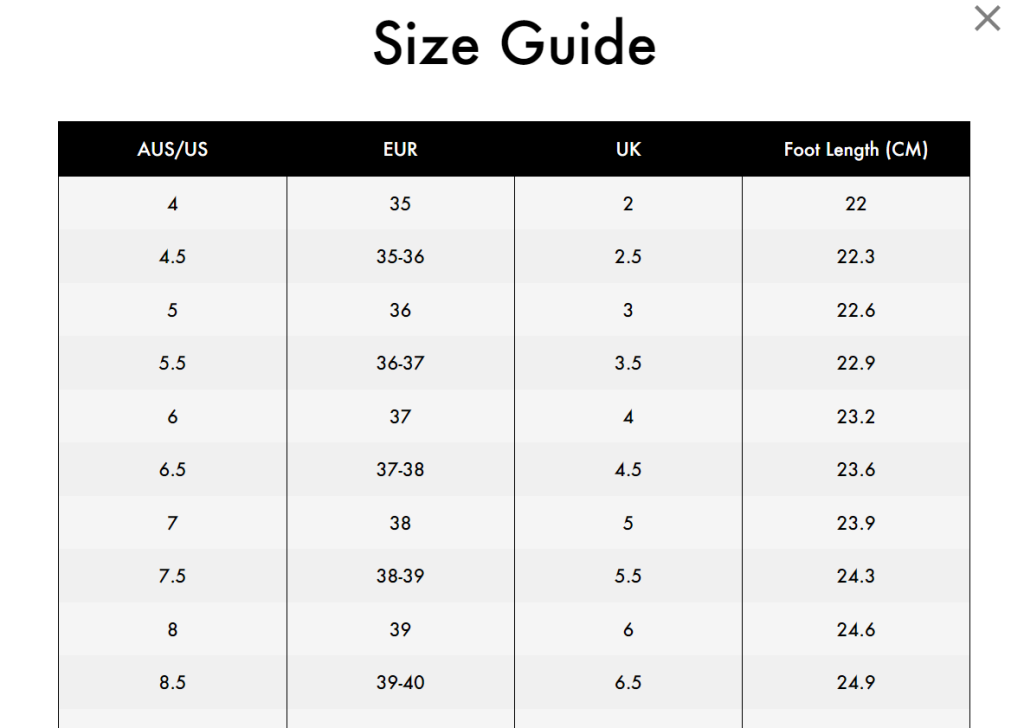Recently, I’ve been searching for a pair of knee high boots for the winter. I looked around here in Leiden but couldn’t find anything I liked so I spent an evening just clicking around on various websites most of which were far out of my price range. This is an obvious observation, but in shopping online as opposed to in-store there is a trade off. We give up sensory and physical information like the feeling of the shoe and its fit on our body for the convenience of shopping from bed at whatever time suits us.
Most of these websites offer a sizing chart, but barely any of them provide more than the most basic foot length to shoe size conversion. This presented a problem when every boot I looked up reviews for had at least one warning about how the boot didn’t or barely fit around the reviewer’s calf. One website even noted that their size chart may not be accurate due to differences in design between different boot models which I found ridiculous considering one pair of their boots costs more than my rent.
I can’t imagine that sizing in fashion has ever been consistent between brands or even within brands all the time, but it’s only very recently that the average person has been able to purchase a piece of clothing fully made without ever seeing it on their body or even having access to the measurements to compare it to their body. 30 years ago, one would see a model wearing a pair of boots and this would convince them to go to the store and try them on for themselves before buying. Now, we are able to see the boots on the model, buy them, and try them on a week later when the package arrives. If after a week the boots don’t fit like you thought they would, there’s a bigger sense of disappointment because you already spent money and anticipation on them, and now it’s gonna be a whole ordeal to return them. At this point, even if you know better, it’s easy to blame your body for not fitting the clothes rather than the other way around.

Solutions
This is obviously not a viable way to correctly size and purchase boots, but how can the situation be improved? Does a brand have a responsibility to provide measurements for their clothes online? Do companies even want to provide detailed sizing charts or do they get more money from people who can’t be bothered to return clothing that doesn’t fit? Even if measurements are provided, how close can that get to the actual physical fit considering different textiles and stretch? Does the average online shopper care, or are they happy with their side of the comfort trade-off as it stands currently?
I think that if you’re selling 800 Euro shoes online, the bare minimum should be to provide the width of the boot around the calf and accurate sizing for each model. I also think in an ideal world there would be a standard for the amount of sizing information an online retailer has to provide, but I’m not sure any amount of numbers could ever measure up to trying on a piece of clothing in person. Maybe in the future, augmented reality will let online shoppers try clothes directly on their bodies with enough accuracy that sizing charts aren’t needed, but even this only accounts for the visual effect of the clothes and not their feeling on the body.


Hi!
This blogpost was really interesting to read because I have never really looked at the connection between digital media and shopping/fashion. In my experience, when I am buying clothes online I will first send the piece of clothing to the store and try it on there. After buying clothes or shoes online and it not fitting nicely, I am no longer a fan of shopping online. Especially when it comes to shoes.
I think its important to address this issue about representing sizing because I have noticed that either shops have completely different sizing but still go by these universal numbers, or there is just not enough information. This becomes even more stressful when the piece of clothing or the shoes are expensive. Furthermore, the disappointment of receiving your package and it not fitting correctly is another experience that just ruins this relationship between technology and fashion for me.
I found your idea about trying on shoes through an augmented reality really interesting – it would truly help the consumer as it easily visualizes the product. Nevertheless, I think that in general there should be more responsibility on the brand and they should just exhibit more sizing details; it’s an important yet easy step forward.
I really agree, because I was also buying boots a few days ago, and after a week-long search and struggle on the website, I finally went into a physical store to buy them. This really needs to be considered, as online shopping becomes increasingly common, what more sophisticated services should online merchants provide to meet consumers’ shopping needs.